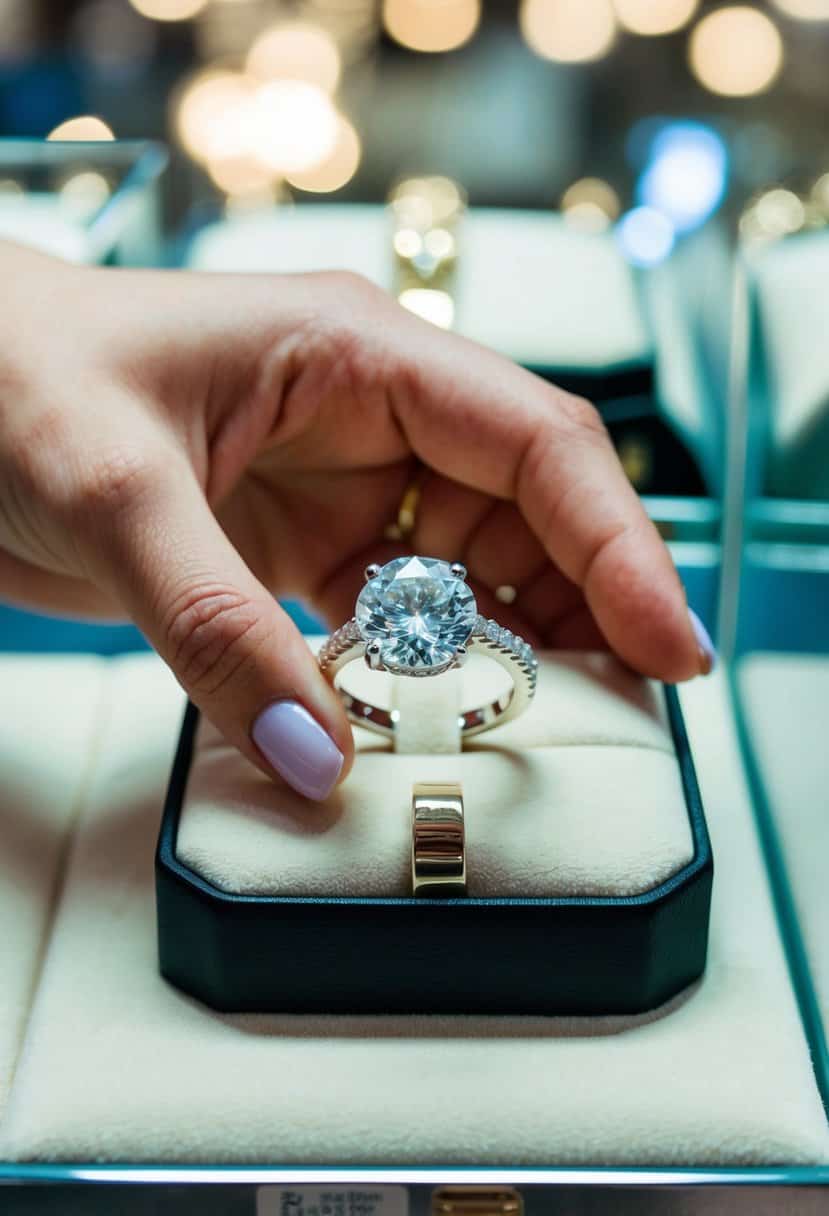What is the 3-Month Salary Rule for Engagement Rings? A Friendly Guide
When choosing the perfect engagement ring, you might hear about the “3-month salary rule.” This idea started as a marketing strategy by De Beers to encourage spending more on rings. The rule suggests that you should reserve three months of your salary for this symbol of love. But in reality, how much you spend on an engagement ring is a personal decision and should reflect your budget and values.

Choosing an engagement ring is not just about following a rule, but finding something that speaks to you and your partner’s unique relationship. Knowing about the 3-month salary rule gives you a guideline, but it’s not set in stone. The reality is that your choice should make you and your partner happy without causing financial stress.
As you consider this investment, think about what truly matters to you and your partner. Engagement rings come in different styles and prices, so it’s possible to find one that fits your budget and holds deep personal meaning.
Understanding both your finances and your partner’s taste will help you celebrate your journey together without worry.
Understanding the 3-Month Salary Rule

The idea behind the 3-month salary rule is often debated among couples planning to buy an engagement ring. This section will discuss where this rule originated and how people view it today.
Origins of the Rule
The 3-month salary rule started as a marketing campaign by De Beers in the 1930s. Its goal was to encourage people to spend more money on diamond engagement rings and increase demand for these gems. The campaign suggested that spending three months of your salary would show your love and commitment.
This rule was popularized over time, turning into a perceived guideline. It aimed to help buyers decide how much to spend without considering individual financial situations. The focus on diamonds helped boost their status as a symbol of love.
Contemporary Perspectives
Today, the 3-month salary rule is seen differently by various people. Many believe personal finances should guide your engagement ring budget, not an old advertisement. You might find it more practical to consider your unique financial status and preferences.
Modern couples often discuss their budget and choose a ring that suits both their style and affordability. Some people also prefer alternative stones to diamonds, reflecting personal values or tastes. The increased variety in ring choices allows more flexibility for couples today.
How to Calculate Your Engagement Ring Budget

Calculating your engagement ring budget involves more than just a simple salary formula. It’s important to consider personal factors like income, savings, and financial goals. This section will help you navigate various factors affecting your choice and explore alternatives to traditional rules.
Factors Affecting Budget
Your salary will definitely influence your engagement ring budget, but other factors are just as important. Think about your current expenses and savings. Do you have existing debts or financial goals you need to meet?
Balancing these can help you decide how much to allocate for a ring.
Another key consideration is the average engagement ring cost in your area. This gives you an idea of what people typically spend but remember it’s just a guideline.
Don’t forget about age. Younger couples may not have the financial stability that older couples might. If you’re younger, it may make sense to spend less and invest more in the future instead.
Alternatives to the 3-Month Rule
The traditional 3-month salary rule suggests spending three months’ worth of salary on a ring. This isn’t always the best approach. Some consider it outdated, as it doesn’t account for personal financial situations. Instead, you might follow a two-month rule or even a one-month rule.
Fixed percentage budgeting can be a helpful alternative. You could set aside a specific percentage of your income instead. This may allow for a more balanced approach that matches your personal finances.
Using an engagement ring calculator can help in planning a budget that suits your lifestyle.
It’s also a good idea to discuss budgets openly with your partner. Being on the same page about financial priorities can build a strong foundation for your relationship.
Choosing the Right Engagement Ring

Finding the perfect engagement ring involves understanding different designs, custom options, and selecting the right gemstones or diamonds. It’s about choosing a ring that reflects personal style and individual preferences.
Engagement Ring Designs
When considering engagement ring designs, you have many options. Classic designs like the solitaire are timeless. They feature a single diamond or gemstone, creating a simple yet elegant look.
Other popular styles include the halo, which surrounds the main stone with smaller diamonds for added sparkle.
You might also explore vintage-inspired designs that include intricate details and unique settings. Modern designs often incorporate mixed metals and sleek, minimalist styles.
It’s crucial to match the design with your personal taste and lifestyle. Think about daily wear and how the ring fits into your everyday activities.
Custom Engagement Ring Options
Custom engagement rings allow for personalization, making the ring truly unique. You can work with a jeweler to create a custom engagement ring that meets your specific desires.
This option lets you choose every element, from the band to the stone.
Custom rings are perfect for those who want to incorporate meaningful details. Perhaps you want to include birthstones or engrave a special message.
Consider these steps:
- Choose the metal type, like gold or platinum.
- Select a band style or pattern.
- Customize the setting and choose additional stones.
Personalizing your ring means it will hold special significance and cater to your unique tastes.
Selecting Gemstones and Diamonds
Diamonds remain a popular choice for engagement rings, known for their durability and brilliance. When selecting diamonds, consider the four Cs: carat, cut, clarity, and color. These factors affect the stone’s appearance and price.
If you’re leaning toward something different, gemstones can add color and flair. Options like sapphires, emeralds, and rubies can make a bold statement.
Be sure to think about the wearer’s personality and style.
For those on a budget, lab-grown diamonds offer a more affordable alternative without compromising on beauty.
Remember:
- Larger carats mean higher prices.
- Choose gemstones based on durability for lasting wear.
Understanding your options helps in making an informed choice that fits both your budget and preferences.
The Significance of Diamonds in Engagement Rings

Diamonds play a crucial role in engagement rings, standing as lasting symbols of love and commitment. Their brilliance and durability make them a popular choice for such an important piece of jewelry. When purchasing a diamond ring, factors like carat weight, quality, and ethical sourcing are important to consider.
Diamonds as a Symbol of Commitment
Diamonds have long been associated with love and commitment. Their timeless beauty and exceptional hardness make them ideal for engagement rings. The tradition of giving a diamond ring is thought to have originated because diamonds, with their brilliant sparkle, were seen as an emblem of devotion and eternal love.
When you present a diamond ring to your partner, it symbolizes your promise to share a future together. This makes the moment even more meaningful and memorable.
Carat Weight and Quality
The carat weight of a diamond significantly influences its appearance and price. Larger carats often mean a more noticeable gem, but the quality of the diamond also matters. A well-cut diamond with good clarity and color will shine brightly, even if it is smaller.
Quality is measured using the 4Cs: carat, cut, color, and clarity. Understanding these will help you choose the best diamond for your needs and budget. A balance between size and quality often offers the best value and beauty.
Ethical Considerations and Mined Diamonds
When choosing a diamond, it’s important to consider where the gem comes from. Mined diamonds can sometimes raise ethical concerns, such as environmental impact and labor conditions.
Many people now look for diamonds certified as conflict-free or sustainably sourced. This ensures that your investment helps support ethical practices in the diamond industry.
By opting for responsibly sourced diamonds, you can celebrate your love while also caring for the world around you.
Practical Tips for Buying an Engagement Ring

Buying an engagement ring can feel like a big task, but a bit of knowledge about wedding etiquette and smart purchasing can help. Here are some practical tips covering essential aspects.
Understanding Wedding Etiquette
Wedding etiquette plays an important role when you buy an engagement ring. Traditionally, many follow the 3-month salary rule, but this is not mandatory. Consider what feels appropriate to you and your partner.
It is polite to consider the partner’s style and preferences. You might ask family or friends for opinions. It’s okay to break from tradition; prioritize what will make your partner feel special and valued.
Remember: Etiquette is about respect and thoughtfulness, not rules. Knowing your partner’s ring size and favored metal type is also part of good etiquette. You’ll want the ring to fit perfectly when you propose.
Making an Informed Purchase
Start by researching the 4 Cs of diamond quality: cut, color, clarity, and carat. These factors impact the price and appearance of the ring.
Visit multiple jewelers to compare designs and prices. Online resources can offer additional insights into different styles and settings.
Consider alternative stones like sapphires or emeralds if diamonds are too costly. Setting a budget in advance is crucial to avoid overspending. Some jewelers offer financing options, allowing you to pay over time.
Be sure to ask about return policies and warranties. These can provide peace of mind by covering adjustments or repairs if needed later on.


